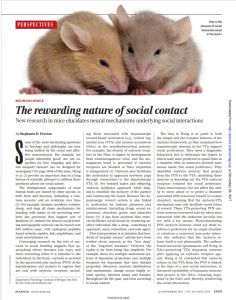Join getAbstract to access the summary!

Join getAbstract to access the summary!
Stephanie D. Preston
The Rewarding Nature of Social Contact
New research in mice elucidates neural mechanisms underlying social interactions
Science, 2017
What's inside?
Social contact is rewarding – in mice and in humans alike.
Recommendation
What does meeting an old friend, playing with your child and hugging your dog all have in common? Social interaction. A specific brain circuit is working hard behind the scenes to create and reinforce such interactions. Psychology professor Stephanie Preston evaluates research conducted by Stanford University professor Robert Malenka and his colleagues. It studies mice to understand the brain mechanisms involved in social behavior. The findings suggest that the neuropeptide oxytocin modulates excitability and the release of the neurotransmitter dopamine. getAbstract recommends Preston’s analysis to those who are interested in social interaction and its relation to neuroscience.
Summary
About the Author
Stephanie D. Preston is an Associate Professor of Psychology at the University of Michigan. She uses an interdisciplinary approach to study the decision-making behind food-gathering behavior.
















Comment on this summary